Search this site ...
African Jewelry
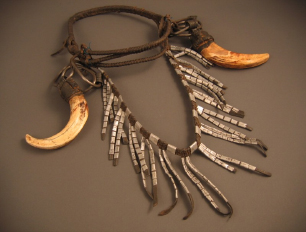 Tribal necklace, tusk, shell, leather, African Heritage Gall, Rome
Tribal necklace, tusk, shell, leather, African Heritage Gall, RomeAfrican Jewelry takes many forms and has a number of functions besides bodily adornment.
It can be storage of wealth; amassing gold or precious metals or stones in bracelets and amulets; or it can be a symbol of prestige and power reflecting status in society… or it can just simply be a decorative item used to hold hair back.
The oldest African jewelry ever discovered was recently found, in 2004, in the Blombos cave on the southern tip of S. Africa. They are estimated at being over 75 000 years old and are pea-sized, mollusc shell beads that had been pierced. They have worn areas indicating that they were probably once strung into a necklace or bracelet.
There are other African beads dating back 45,000 years.
 ancient stone bead
ancient stone bead Mollusc shell beads Blombos, 75,000 yrs BC
Mollusc shell beads Blombos, 75,000 yrs BCThe oldest African jewelry ever discovered was recently found (2004) in the Blombos cave on the southern tip of S. Africa. They are estimated at being over 75 000 years old and are pea-sized, mollusc shell beads that had been pierced. They have worn areas indicating that they were probably once strung into a necklace or bracelet.
Historically, African jewelry is also used to trade and barter with, mainly in exchange for cloth and food, but also very sadly for slaves.
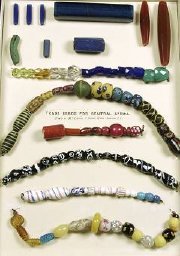 African trade beads, Pitt River Museum, Oxford
African trade beads, Pitt River Museum, OxfordAfrican jewelry is seldom just ornamental; religion, rituals and ceremonies play a large part. Found objects are often included and can carry personal and symbolic meanings for the wearer. Jewelry is worn by men, women and children, in some cases from a very early age and may be replaced at a certain age or status event like puberty, reaching manhood or marriage.
African jewelry has customarily been created from organic materials like hide, porcupine quill, bone, animal teeth, animal hair, seeds, nuts, husks, sea and land shells, egg shell, wood, ivory and carved stone.
Ostrich shells have been discovered in disc shaped form in Palaeolithic and Neolithic sites. Ostrich bone is one of the oldest forms of material used. Cowrie shells have an ancient history in Africa and are prized for their durability and their shape symbolizing female fertility.
 Ostrich egg bead necklace, Sudan, Pitt River Museum
Ostrich egg bead necklace, Sudan, Pitt River Museum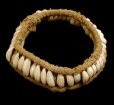 Cowrie bracelet
Cowrie braceletIn Benin during the 15th C, stone beads were expertly carved and in the 16th C coral beads brought from the coast by Portuguese traders were incorporated into necklaces. In Kenya, the Turkana have manufactured large, faceted iron beads for generations.
From the 1400's and at its height in the 1800's, molded glass and ceramic trade beads, brass bells and coins were introduced to add extra choice of embellishment. Copper and iron alloys were used to produce pendants and simple jewelry. Ivory and amber have also had a tremendous influence in trade and handicrafts on the African continent. The former was especially treasured in Benin in the 16th Century.
Traditionally African jewelry has been used to adorn necks, ears, arms, legs, toes, hair and waists and can be pierced, strapped or sewn on. Sometimes it can be left for long periods of time causing physical body damage and restricting movement.
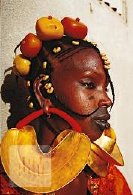 Amber and gold adornment, Mopti
Amber and gold adornment, Mopti- Necklaces
- Bracelets
- Anklets
- Earrings
- Nose rings
- Headdresses, headbands
- Hair ornaments
- Clasps for cloth and wraps
- Corsets
Tribal African jewelry is dependent upon three things:
- what is available locally
- what has been traded and bartered for over the centuries
- what the customs and traditions are in the different cultures.
For example, the lost wax method of bronze casting in Nigeria and Benin started by the Yoruba in the 13th C has produced very intricate modelling of bronze pieces and copper is another metal historically used.
In Ghana, the coronation of kings and leaders is celebrated with a show of gold wealth that is astounding in its glory. Gold bracelets, necklaces and rings all have symbolic meaning attached to the styling and motifs used in the making.
When tribes are nomadic like the Turkana, Dinka and Samburu in Sudan and Kenya, their creativity is given an outlet in the form of personal adornment.
Jewelry is worn to express tribal association, age, civil and marital status and wealth.
Beaded African jewelry can give out as much information as is written or spoken, it has its own language and much can be derived about history, culture and status. In southern and eastern Africa, most inhabitants can wear beaded refinement but in Yoruba culture it is confined to rulers and in the Cameroon, beads are an expression of privilege.
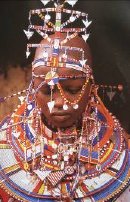 Beaded corset , Dinka
Beaded corset , DinkaThe Kenyan bride, at left, is in traditional beaded adornment including aluminium 'birds' to attract sunlight and therefore the attention of her groom. Bead culture, hugely and enthusiastically adopted by many tribes, is a relatively new one in Africa.
The earliest known Maasai and Samburu items are dated around 1850; large red beads that were taken back to Holland.
 Mali wedding beads
Mali wedding beadsWith the introduction of small, colourful glass beads from Italy and other parts of Europe, a whole mythology built up around the beads with colours and band or block patterns playing a significant role.
Neckbands became the primary piece of African jewelry for men and women.
African Jewelry items tend to be big and bold and chunky using ethnic and metal beads, ostrich and ebony discs, beaten silver and mineral stones.
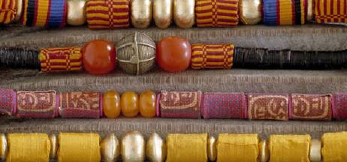 African necklaces using fabric covered, amber, red coral and metal beads
African necklaces using fabric covered, amber, red coral and metal beadsGemstones, precious and semi precious, new and antique, have decorative and spiritual properties that are highly valued and increasingly in demand. Luckily, Africa is hugely wealthy with resources in this area and the supply of materials comes easily.
Diamonds, interestingly, are culturally seen as devoid of colour and were not traditionally favoured by the indigenous people of Africa.
Above is a selection of jewelry designed using antique and ancient beads in a contemporary fashion. Stones used by African artisans include turquoise, lapis lazuli, sapphires, emeralds and rubies as well as topaz, amethyst, rose quartz and moonstone.
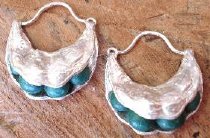 freeRange silver and turquoise pod earrings
freeRange silver and turquoise pod earringsThese silver earrings are a contemporary take on traditional Fulani hoops blending natural mineral elements with tribal design.
Modern Tribal Jewelry
Below is a collection of tribal jewelry found in a specialist market in St Louis, Senegal. Turkana, Masai, Zulu... too many tribal sources to mention are gathered together for sale in an established tourist orientated market.
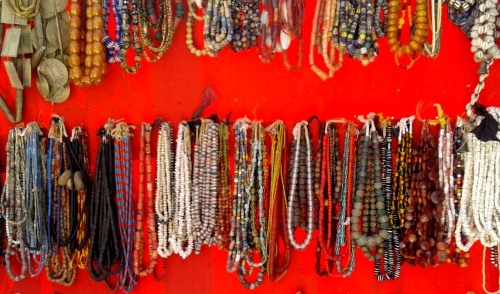 Tribal collection, St Louis market, Senegal, CAA photo
Tribal collection, St Louis market, Senegal, CAA photo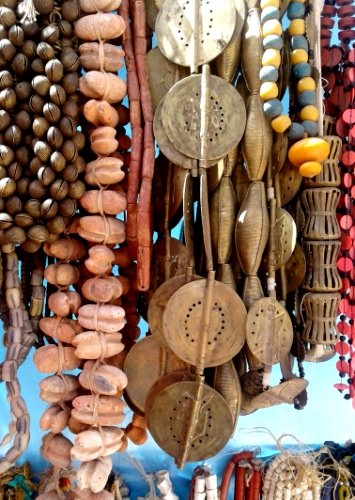 detail of the selection, St Louis
detail of the selection, St LouisUndeniably beautiful and attractive, traders will transport both beads and strung items for literally thousands of kilometers to open markets where tourists and enthusiasts come to buy.
The market is competitive and genuine articles are appreciated and given the value they deserve.
Specialist collier makers and designers like Benin born Marie-Jose Crispin of Goree Island, Dakar take pride in collecting valuable beads, stones, bones, metals and artifacts and stringing them together to make magnificent unique, one-off items.
These are, in fact, research items and often give testament to how far a single item can travel... and of the ways it can travel; like appearing in the sand or in a bequeathed or discovered box or trunk after someone has died.
This extraordinary image below is the work of a young photographer John Kenny whose beautiful work captures traditional jewelry worn in modern time. The hair clips are give-aways! An exquisite image documentation to her heritage.
Contemporary African Jewelry
African jewelry is interpreted in many ways in the contemporary fashion world. Black models are very in vogue and tribal adornment embellishes and enhances many necks and bodies of all races.
Today jewelry manufacture has become an art form and a way to express one's personality, a form of individual expression.
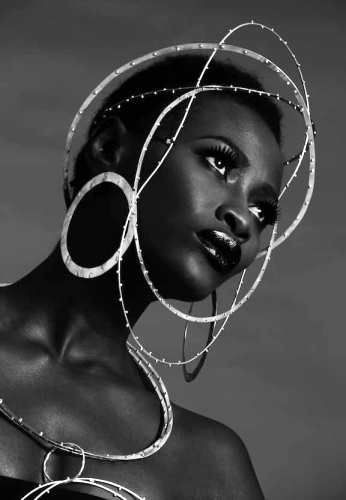 "Self-Image Awareness & Transformation" by Rania Odaymat, Photographer - Eric Don-Arthur, Model- Belinda Baidoo
"Self-Image Awareness & Transformation" by Rania Odaymat, Photographer - Eric Don-Arthur, Model- Belinda BaidooSince 'jewelry' is derived from a Latin word 'jocale' which means 'plaything' we can see that historically it has been used as a form of adornment that gives pleasure and status to its wearer.
With access to beautiful stones, precious metals and other unusual material source like fossils and ebonised wood, there has been an explosion of phenomenal design in the jewelry world.
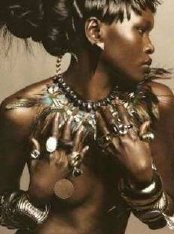 Image from Trendsetter online magazine
Image from Trendsetter online magazine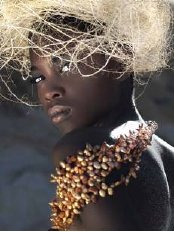 Freshwater pearls Rockchic
Freshwater pearls Rockchic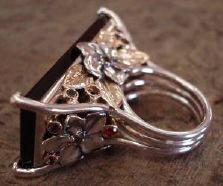 Flower box ring, FreeRange Jewellery, SA
Flower box ring, FreeRange Jewellery, SACreativity is at an all time high.
Piece - this is a collection that pays tribute to the creative power of the African people and how the use and trade of beads has been so significant in Africa's history and culture.
Designed in collaboration with Beauty Maswanganyi a master beader, the collection seeks to reflect the contribution of San bushmen with their ostrich shell beads, the African blacksmith who made cast bronze beads, the Mozambican precious natural resources with hand carved timber beads and West African communities who used cowrie shells as currency.
Coral and amber, both rare and beautiful, and symbolizing status, investment and fertility are majestic additions in the creations.
Contemporary recycled Jewelry
One of the recurring themes we see when looking at art on the African continent is the way artisans are making the most incredible recycled product.
Jewelry is no exception and below are a few examples of the creative energy being applied in this area.
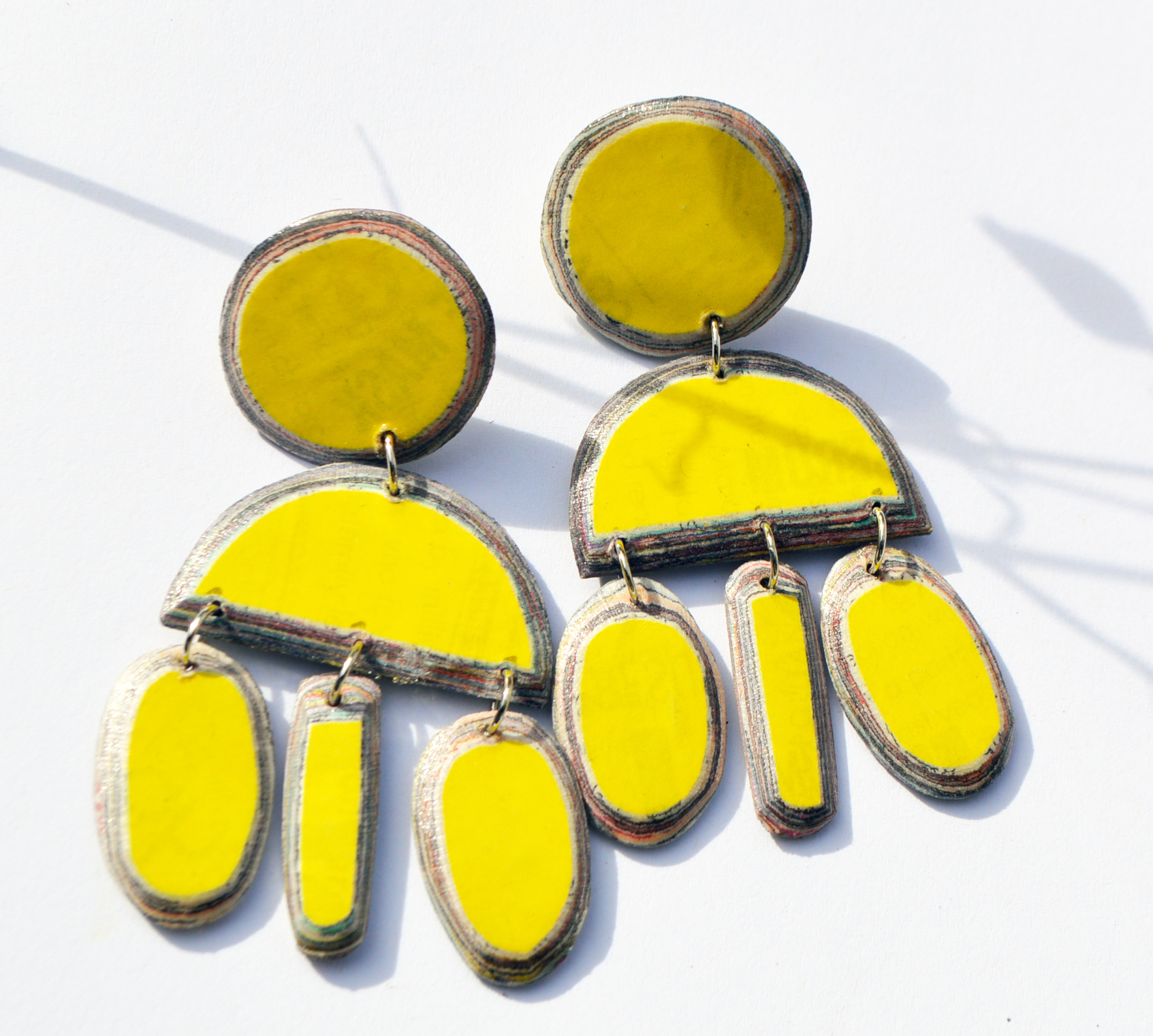 nesta-earrings-quazidesign, Swaziland
nesta-earrings-quazidesign, SwazilandIt's an exceptionally good practice for so many reasons:
- the commercial gain of the individual or community
- the experience and skills acquired not only in creation of the product but also learning to manage the finances and marketing
- the commitment to cleaning up the environment
- the artistic growth of individuals and the value perceived in creating something beautiful from very little
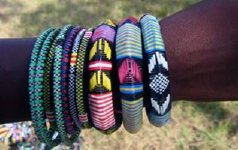 Recycled plastic bracelets, Burkina Faso
Recycled plastic bracelets, Burkina Faso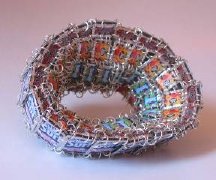 Kenya, recycled glass bead jewellery
Kenya, recycled glass bead jewellery Kenya, recycled glass bead jewellery
Kenya, recycled glass bead jewelleryThe products featured above seek to do all those things and are effective in achieving success.
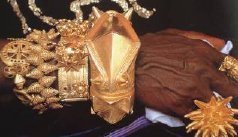
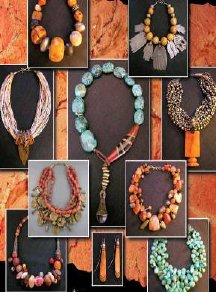
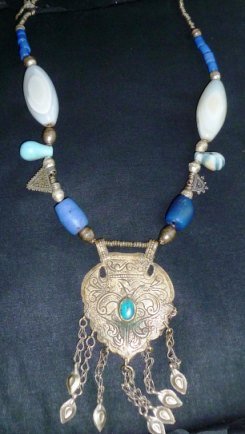
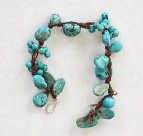
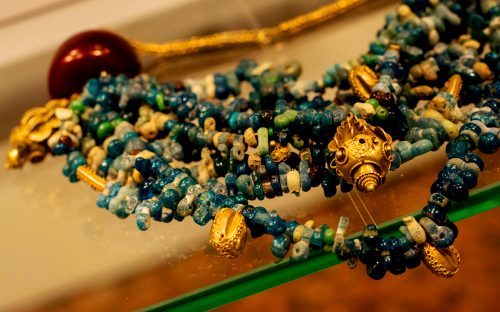
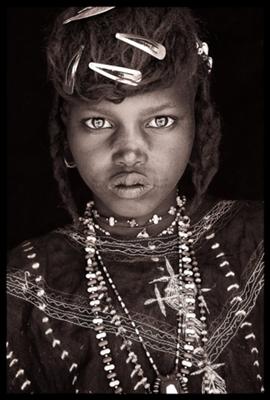
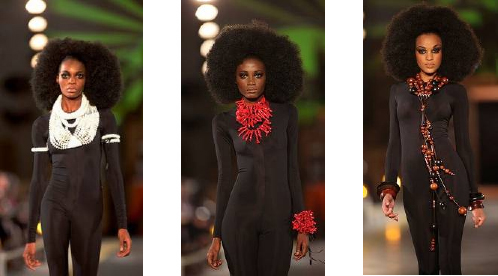
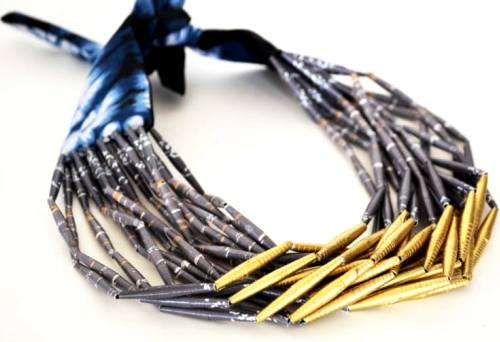
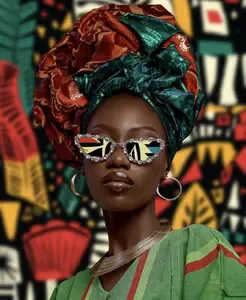
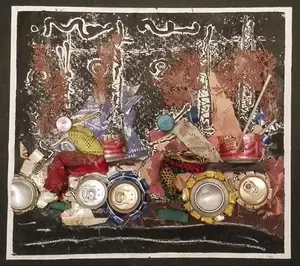
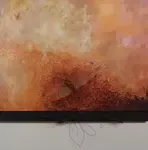

New! Comments
Have your say about what you just read! Leave me a comment in the box below.